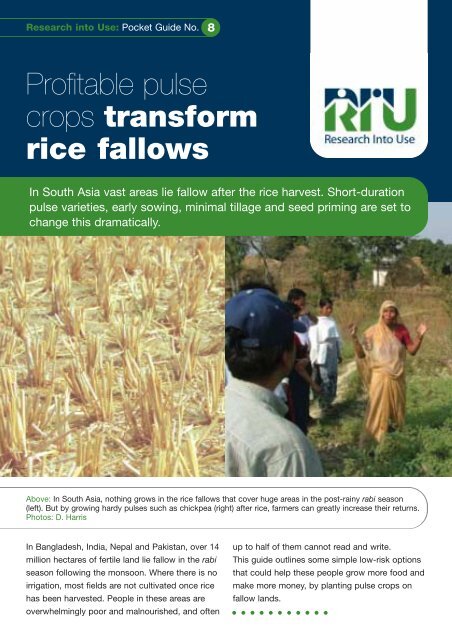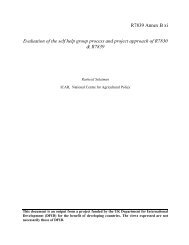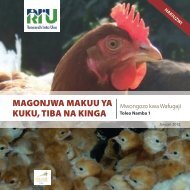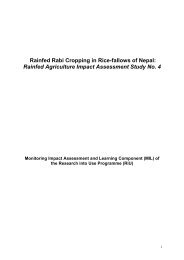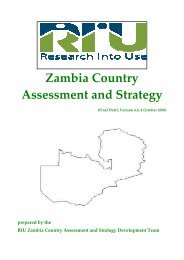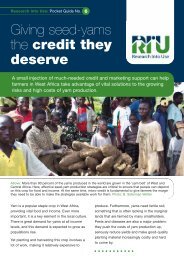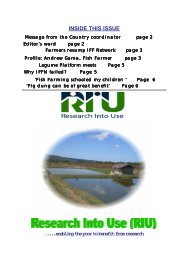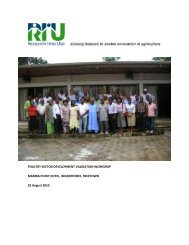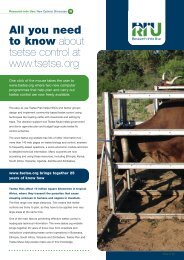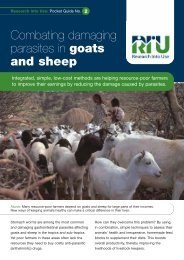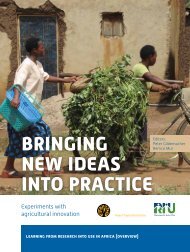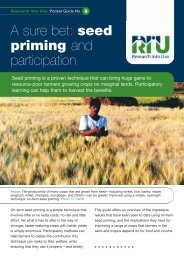Profitable pulse crops transform rice fallows RIU Pocket Guide 8
Profitable pulse crops transform rice fallows RIU Pocket Guide 8
Profitable pulse crops transform rice fallows RIU Pocket Guide 8
Create successful ePaper yourself
Turn your PDF publications into a flip-book with our unique Google optimized e-Paper software.
Research into Use: <strong>Pocket</strong> <strong>Guide</strong> No.<br />
8<br />
<strong>Profitable</strong> <strong>pulse</strong><br />
<strong>crops</strong> <strong>transform</strong><br />
<strong>rice</strong> <strong>fallows</strong><br />
In South Asia vast areas lie fallow after the <strong>rice</strong> harvest. Short-duration<br />
<strong>pulse</strong> varieties, early sowing, minimal tillage and seed priming are set to<br />
change this dramatically.<br />
Above: In South Asia, nothing grows in the <strong>rice</strong> <strong>fallows</strong> that cover huge areas in the post-rainy rabi season<br />
(left). But by growing hardy <strong>pulse</strong>s such as chickpea (right) after <strong>rice</strong>, farmers can greatly increase their returns.<br />
Photos: D. Harris<br />
In Bangladesh, India, Nepal and Pakistan, over 14<br />
million hectares of fertile land lie fallow in the rabi<br />
season following the monsoon. Where there is no<br />
irrigation, most fields are not cultivated once <strong>rice</strong><br />
has been harvested. People in these areas are<br />
overwhelmingly poor and malnourished, and often<br />
up to half of them cannot read and write.<br />
This guide outlines some simple low-risk options<br />
that could help these people grow more food and<br />
make more money, by planting <strong>pulse</strong> <strong>crops</strong> on<br />
fallow lands.
Research into Use: <strong>Pocket</strong> <strong>Guide</strong> No. 8<br />
2<br />
Making the most of <strong>fallows</strong><br />
After the <strong>rice</strong> harvest, farmers traditionally<br />
avoid growing <strong>crops</strong>. In the rabi season rains<br />
are erratic and droughts mean <strong>crops</strong> frequently<br />
fail. Although some moisture remains in the soil,<br />
farmers find that seed germination is uncertain as<br />
the paddy fields dry out and hard layers of soil<br />
(hard pans) form. Their <strong>crops</strong> often don't mature<br />
before drought sets in. And livestock set loose to<br />
graze the fallow fields damage their <strong>crops</strong>. Most<br />
farmers see post-rainy season <strong>crops</strong> grown<br />
without irrigation as being very risky.<br />
Above: Rice growing in the monsoon kharif season.<br />
Photo: D. Harris<br />
Many of these farmers are beyond the reach of<br />
over-extended extension services. So they don't<br />
know that there are now simple ways to<br />
overcome the problems of rabi season <strong>crops</strong>.<br />
Early-maturing varieties of hardy <strong>pulse</strong>s, low-cost<br />
seed treatments and simple farming practices<br />
mean less risk and good returns.<br />
Rabi <strong>crops</strong> can also provide work at a time of<br />
year when agricultural labour—which accounts<br />
for over three-quarters of the population in Nepal<br />
and two-thirds in India—is mostly idle. For<br />
example, one hectare of chickpea employs<br />
someone for 50 days. Very simple projections<br />
suggest that if only one-third of all <strong>rice</strong> fallow<br />
land was used to grow <strong>pulse</strong>s, it could provide<br />
rural workers with 95 million days of work in the<br />
rabi season in India alone.<br />
Farmers can profit from <strong>pulse</strong>s<br />
After the monsoon kharif season, once <strong>rice</strong><br />
has been harvested, paddy field soils are<br />
still damp. These soils are usually highly fertile.<br />
Above: Land left fallow in the rabi season.<br />
Photo: D. Harris<br />
So, instead of just leaving the fields fallow during<br />
the rabi season, farmers can use the moisture left<br />
in the soil to grow <strong>pulse</strong>s. Pulses, or legumes as<br />
they are also known, have deep roots and can be<br />
grown without irrigation.<br />
Soybean, mung bean, black gram, pigeonpea,<br />
groundnut, chickpea, lentil, khesari, faba bean<br />
and pea are all suitable for fallow paddies. But<br />
<strong>rice</strong> fallow areas vary widely. Involving farmers<br />
helps the development of varieties adapted to
differing climates, soils and consumer<br />
preferences.<br />
At the end of the monsoon, soils quickly dry out.<br />
But seed priming—soaking seed overnight in<br />
water—helps germination and gives seedlings a<br />
head start. This simple practice raises yields of<br />
chickpea by over 40 percent and costs practically<br />
nothing. Farmers who tried it found their incomes<br />
were 12 percent higher than those who didn't.<br />
Pulses are hardy and, unlike <strong>crops</strong> such as wheat<br />
that must be irrigated in the rabi season, they<br />
need little in the way of capital or inputs.<br />
Including legumes in <strong>rice</strong> rotations adds nitrogen<br />
and organic matter to the soil and improves <strong>rice</strong><br />
yields—a bonus as returns from <strong>rice</strong> are falling.<br />
Involving farmers helps<br />
the development of<br />
varieties adapted to<br />
differing climates, soils<br />
and consumer<br />
preferences<br />
Pulses are more profitable than irrigated rabi<br />
<strong>crops</strong> such as wheat because they have low<br />
input costs and the grain fetches high p<strong>rice</strong>s.<br />
Demand in the region is strong and set to rise.<br />
Domestic supplies are already inadequate and<br />
most countries import large quantities. The young<br />
shoots and green pods of chickpea are popular<br />
as a vegetable and snack, and also fetch good<br />
market p<strong>rice</strong>s.<br />
Pulses are important as a low-cost protein food.<br />
For vegetarians—who make up a third of the<br />
region's population—they are a vital part of<br />
the diet.<br />
Above: In the Barind of<br />
Bangladesh, low-input chickpea<br />
(right) gives better returns than<br />
irrigated wheat (left).<br />
Photo: D. Harris<br />
Introducing rabi <strong>pulse</strong> <strong>crops</strong> to <strong>rice</strong> <strong>fallows</strong> is<br />
low-cost and can raise both yields per hectare<br />
and incomes for some of the region's poorest<br />
farmers. Plus, <strong>rice</strong>—<strong>pulse</strong> rotations conserve<br />
both land and water while producing more food<br />
and employing more labour.<br />
3
Research into Use: <strong>Pocket</strong> <strong>Guide</strong> No. 8<br />
4<br />
Growing <strong>crops</strong> in <strong>rice</strong> <strong>fallows</strong>:<br />
the practicalities<br />
Start the process with farmers<br />
It's been found that the best way to<br />
introduce farmers to <strong>pulse</strong>s as a fallow crop<br />
after monsoon <strong>rice</strong> is to find a small group<br />
of interested farmers and work with them.<br />
Each farmer needs to agree to plant <strong>pulse</strong>s on<br />
part of his/her land. If possible, the plots should<br />
be next to each other and about 2-3 hectares in<br />
all. This makes it easier to protect the trial plot<br />
from grazing animals.<br />
Work towards getting early<br />
<strong>rice</strong> harvests<br />
The earlier <strong>rice</strong> can be harvested, the<br />
earlier the follow-on crop can be sown.<br />
Early harvests mean that more moisture remains<br />
in the soil for the next crop. Early-maturing<br />
varieties, developed in partnership with farmers,<br />
are now available that can bring the <strong>rice</strong> harvest<br />
forward by ten days or more. This makes a big<br />
difference. Another way of bringing the harvest<br />
forward is direct seeding where, instead of<br />
transplanting <strong>rice</strong> seedlings, <strong>rice</strong> is sown directly<br />
into paddies. In this case, more resources need<br />
to be spent on weeding.<br />
Conserve soil moisture<br />
It's important to keep as much moisture in<br />
the soil as possible. This means minimum<br />
tillage—quickly preparing the soil for sowing<br />
without too much disturbance.<br />
Treat seeds before sowing<br />
'Priming', that is soaking seed overnight,<br />
helps seed germinate and gives seedlings a<br />
head start. After priming, the seeds need to dry<br />
just enough to be sown easily. Soaking chickpea<br />
before sowing costs practically nothing yet has<br />
proved outstandingly effective in many places,<br />
including northwestern Bangladesh.<br />
Seed priming is easy, low-cost, low-risk<br />
and very effective<br />
Soak seeds for 4-6 hours in water. For each<br />
kilogram of seed, add 0.5 g sodium<br />
molybdate in 1 litre of water and 5 g<br />
Rhizobium inoculum in 1 litre of water.<br />
Adding Rhizobium to the soaking water<br />
helps the seedlings form nitrogen-fixing<br />
nodules which capture nitrogen from the air.<br />
This is especially true where soils are acid,<br />
which is often the case in <strong>rice</strong> paddies.<br />
Molybdenum is an essential micronutrient<br />
for chickpea. Tiny amounts of molybdenum<br />
improve Rhizobium nodulation.<br />
Soaking seed in water alone dramatically<br />
improves germination. But, priming seeds<br />
with both molybdenum and Rhizobium (as<br />
above) raises yields by a third compared to<br />
priming with just water.<br />
Choose <strong>pulse</strong> varieties that<br />
mature early<br />
The varieties for follow-on <strong>pulse</strong> <strong>crops</strong><br />
need to flower and set seed early. This is<br />
because they need to be ready to harvest in<br />
75-80 days—before they have used up all the<br />
soil moisture. Normally chickpea takes 120<br />
days to mature.
Seed priming is easy,<br />
low-cost, low-risk<br />
and very effective<br />
Above: Soaking seeds overnight (priming) gives<br />
higher yields of yellow chickpea (right) than<br />
planting non-primed seeds (left). Farmers and<br />
researchers have worked together to determine the<br />
optimum soaking time for many of the <strong>crops</strong> that<br />
smallholders in the semi-arid tropics depend upon<br />
for food and income. Photo: D. Harris<br />
And, choose <strong>pulse</strong> varieties<br />
that are resistant to common<br />
local pests<br />
In some areas, pests such as pod borers<br />
can be a problem. Here it's important to<br />
choose pest-resistant varieties or <strong>crops</strong> that<br />
aren't so susceptible. What's more, integrated<br />
pest management (IPM) is very important in lowinput<br />
rabi <strong>crops</strong>. IPM can include the use of<br />
nuclear polyhedrosis virus (NPV) as a spray. This<br />
is very effective in controlling pod borers when<br />
they are detected on leaves in the late stages of<br />
crop development.<br />
Farmers know what works<br />
for them<br />
Involving farmers in choosing and testing<br />
varieties—known as participatory varietal<br />
selection—helps match <strong>crops</strong> to local soils,<br />
climate, markets and consumer<br />
preferences. Farmer trials with minimum<br />
external inputs—just seed, labour and bullocks—<br />
can be very cost-effective.<br />
Above: The contrast between fallow<br />
and cropped land is clear.<br />
Photo: D. Harris<br />
5
Research into Use: <strong>Pocket</strong> <strong>Guide</strong> No. 8<br />
6<br />
Participatory varietal selection is a way of<br />
choosing crop varieties that:<br />
Includes farmers' criteria in searching<br />
for varieties to test<br />
Meets farmers' preferences and needs<br />
Lets farmers try out varieties in their fields<br />
Distributes the varieties farmers prefer.<br />
Extension services are stretched<br />
to the limits—look into who else<br />
can help<br />
Farmers often have to travel a very long way to<br />
get advice from extension services. And not<br />
many can tune in to radios or TVs as a source of<br />
advice. Increasingly, the trend is for NGOs and<br />
extension services to work closely together. For<br />
example, in eastern Nepal the area of <strong>rice</strong> fallow<br />
sown to <strong>crops</strong> doubled from 40 percent to 80<br />
percent in two years thanks to the NGO<br />
FORWARD (Forum for Rural Welfare and<br />
Agricultural Reform for Development) and the<br />
local District Agriculture Development<br />
Office (DADO).<br />
Low-cost seed storage<br />
Stored seed is prey to beetles, rats and other<br />
pests. Tested ways to safely store seed on-farm<br />
include sun-drying seed, putting seed in thick<br />
polythene bags, making bags airtight, mixing<br />
seed with naphthalene balls and storing bags of<br />
seed on raised platforms in large containers.<br />
Looking after rabi <strong>crops</strong><br />
During the rabi season, free-ranging livestock<br />
graze <strong>fallows</strong> and damage growing <strong>crops</strong>.<br />
Livestock can be kept out more easily if farmers<br />
get together to plant in blocks. Block planting<br />
also means that between them, farmers are more<br />
likely to spot and treat pests and diseases at an<br />
early stage.<br />
A big advantage of legume <strong>crops</strong> is that they<br />
have nodules on their roots that fix nitrogen and<br />
so don't need lots of fertiliser. Where soils are<br />
poor, adding manure, or superphosphate if<br />
farmers can afford it, improves yields.<br />
Farmers need the right seed at<br />
the right time<br />
Quality seed of the right variety at the right p<strong>rice</strong><br />
at the right time is a must. Schemes that help<br />
communities to become self-sufficient in<br />
multiplying, storing and distributing seed have<br />
proved effective. Examples include buy-back<br />
seed production schemes and village seed banks<br />
where farmers contribute seed from improved<br />
<strong>crops</strong> and varieties. Village entrepreneurs can<br />
also play a role here.<br />
Above: Chickpea has nodules on its roots that<br />
fix nitrogen from the air—giving a free source<br />
of fertiliser. Photo: D. Harris
Marketing rabi <strong>crops</strong><br />
Chickpeas, lentils and other <strong>pulse</strong>s find ready<br />
markets. In Madhya Pradesh, farmers feared that<br />
they would find soybean—a new rabi crop—<br />
difficult to sell. However, these fears proved<br />
groundless. The area of soybean quickly grew<br />
and <strong>transform</strong>ed subsistence farming into<br />
commercial farming. Farmers here also found that<br />
the problem of grazing animals destroying <strong>crops</strong><br />
went away rapidly as the benefits of soybean<br />
production became clear and villagers<br />
cooperated to keep animals under control.<br />
P<strong>rice</strong>s play a big part in farmers' choice of <strong>crops</strong>.<br />
Though some countries, for example India,<br />
guarantee minimum p<strong>rice</strong>s for <strong>pulse</strong>s others,<br />
such as Nepal, do not. Involving farmers in<br />
choosing <strong>crops</strong> and varieties means that they<br />
pick only those that they know will fetch good<br />
p<strong>rice</strong>s and that local consumers will accept.<br />
P<strong>rice</strong>s play a big<br />
part in farmers'<br />
choice of <strong>crops</strong>.<br />
For more information and contacts,<br />
please see the back page.<br />
Above: Chickpeas, lentils and other<br />
<strong>pulse</strong>s find ready markets<br />
7
About this series<br />
How can I find out more<br />
For more information contact the <strong>RIU</strong><br />
Programme, NR International, Park House,<br />
Bradbourne Lane, Aylesford, Kent, UK, ME20<br />
6SN, riuinfo@nrint.co.uk.<br />
Further contacts<br />
In all cases, please copy emails to <strong>RIU</strong><br />
Information (riuinfo@nrint.co.uk).<br />
Dr Dave Harris, d.harris@bangor.ac.uk<br />
Dr J.V.D.K. Kumar Rao, j.kumarrao@cgiar.org<br />
Bangladesh—BARI On-Farm Research Division,<br />
Joydebpur, Gazipur, Bangladesh<br />
India—ICRISAT, Patancheru, 502 324 Andhra<br />
Pradesh, India<br />
Nepal—Forum for Rural Welfare and Agricultural<br />
Reform for Development (FORWARD), P.O. Box<br />
11, Bharatpur-2, Kshetrapur, Chitwan, Nepal<br />
See also www.seedpriming.org<br />
Research into Use <strong>Pocket</strong> <strong>Guide</strong>s showcase new<br />
technologies that have been tried and tested, and<br />
have proven successful in the field. They were<br />
produced to demonstrate the importance of highquality<br />
scientific communication.<br />
This <strong>Pocket</strong> <strong>Guide</strong> was developed from research<br />
funded by the UK Department for International<br />
Development (DFID) Plant Sciences Research<br />
Programme (Projects R8427, R8366, R7885,<br />
R8412, R8234, R7471, R8098 and R8221). The<br />
views expressed are not necessarily those of<br />
DFID.<br />
<strong>RIU</strong> is managed by Natural Resources<br />
International Ltd., in partnership with Nkoola<br />
Institutional Development Associates Ltd. (NIDA)<br />
and Michael Flint and Performance Assessment<br />
Resource Centre. <strong>RIU</strong> is funded by DFID.<br />
www.researchintouse.com<br />
The <strong>Pocket</strong> <strong>Guide</strong> series was developed, written, designed and<br />
printed for <strong>RIU</strong> by SCRIPTORIA (www.scriptoria.co.uk)


